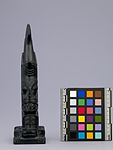gyaaGang (Model Totem Pole)
About this object
History of use
These poles were carved to be ornaments and art objects in non-Haida cultural context. Argillite carvings were first produced for trade to Europeans in the 1820's. Miniature argillite poles were first carved in the 1870's. 20 century pieces tend to incorporate highly individual departures from previous styles, reflecting in some cases a loss of tradition.
Cultural context
commercial art
Iconographic meaning
Crests represented particular kinship groups and may depict elements of myth.
Physical description
Carved argillite, miniature totem pole with flat back. The pole is rectangular in shape with a slight taper at the top and is seated on a rectangular, black base. The figures represented are a large dogfish on top of a frog. The dogfish consists of a flattened face, wide mouth with jagged teeth, and three curved gill slits on cheeks, arched form above head is incised with three curved gill slits and two circles. Large tail fin extends above to form top of pole. An incised arched form is below figure's chin. Incised design of ovoids and u's is on side and tail fins. Base, in form of a frog, with front its feet formed by lines incised over front edge. The bottom has signature 'Henry Young' incised on bottom.
